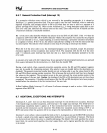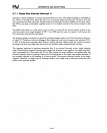
INTERRUPTS AND EXCEPTIONS
9.6.7
General Protection Fault (Interrupt 13)
If
a protection violation occurs which
is
not covered
in
the preceding paragraphs, it
is
classed
as
Interrupt 13, a general protection fault. The error code
is
zero for limit violations, write to read-only
segment violations, and accesses relative
to
DS or ES when they are zero or refer to a segment
at
a
greater privilege level than
CPL. Other access violations (e.g., a wrong descriptor type) push a
non-
zero error code that identifies the selector used
on
the stack. Error codes with bit 0 cleared and bits
I5-2non-zero indicate a restartable condition.
Bit 1 of the error code identifies whether the selector
is
in
the IDT or LDT
/GDT.
If
bit 1
=0
then bit
2 separates LDT from GDT. Bit
0 (EXT) indicates whether the exception
was
caused by the program
or an event external to it (i.e., single stepping, an external interrupt, a processor extension not-present
or a segment overrun).
If
bit 0
is
set, the selector typically has nothing to do with the instruction that
was
interrupted. The selector refers instead to some step of servicing an interrupt that failed.
When bit
0 of the error code
is
set, the interrupted program can be restarted, except for processor
extension segment overrun exceptions (see section 9.6.3). The exception with the bit
0 of the error
code
= 1 indicates some interrupt has been lost due to a fault
in
the descriptor pointed to by the
error code.
A
non~zero
error code with bit 0 cleared may be an operand of the interrupted instruction, an operand
from a gate referenced by the instruction, or a field from the invalid TSS;
During a task switch, when a general protection exception occurs, the ES and DS segment registers
may not be usable for referencing memory (the selector vaues are loaded before the descriptors are
checked). The general protection handler should not rely
on
being able to use the values found
in
ES,
SS, and DS without causing another exception. This
is
because the task switch itself may have changed
the values
in
the registers. The exception occurs
in
the
new
task and the return pointer points to the
first instruction of the
new
task. Caution: the loading of the DS or ES descriptors may
not
have been
completed. The exception
13
handler should ensure that the DS and ES descriptors have been properly
loaded before the execution of the first instruction of the
new
task.
In Real Address Mode, Interrupt
13
will
occur if software attempts to read or write a I6-bit word at
segment offset OFFFFH.
9.7
ADDITIONAL EXCEPTIONS
AND
INTERRUPTS
Interrupts
0,
5,
and I have not yet been discussed. Interrupt 0
is
the divide-error exception, Interrupt
5 the bound-range exceeded exceptions, and Interrupt 1 the single step interrupt. The divide-error or
bound-range exceptions make it appear
as
if that instruction had never executed: the registers are
restored and the instruction can be restarted. The divide-error exception occurs during a DIY or an
IDlY instruction when the quotient
will
be
too
large to be representable, or when the divisor
is
zero.
Interrupt 5 occurs when a value exceeds the limit set for it. A program can use the
BOUND instruction
to check a signed array index against signed limits defined
in
a two-word block of memory. The block
can be locatcd just before the array to simplify addressing. The block's first word specifies the array's
lower limit, thc second word specifies the array's upper limit, and a register specifies the array index
to be tested.
9-13


















